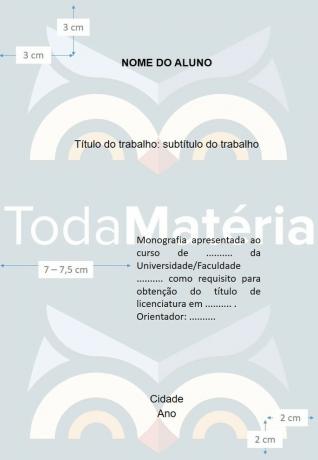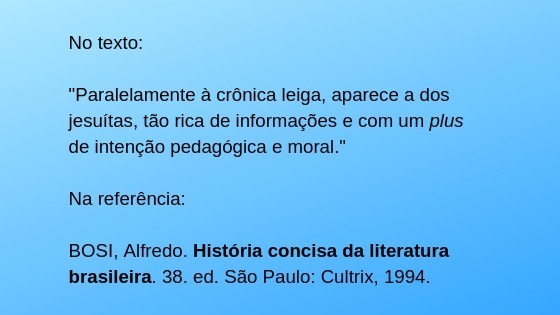Check out a step by step and a model of cover sheet to help you do your job in accordance with ABNT (Brazilian Association of Technical Standards) standards.
THE cover sheet it consists of two pages (front and back), where data about the author, course, title, subtitle and objective of the work, among others, are presented. These pages are made available immediately after the cover.
ABNT cover sheet template
The cover sheet consists of obverse and verse, and is mandatory in academic papers such as TCC (Course Completion Paper) and monograph.
Although it is not the term used by ABNT to designate this item, the word back cover it is often used as a synonym for a cover sheet.
Check out a template below to learn how to make your cover sheet.


Front page obverse elements
Below you'll find a guide with everything you need to know to start designing your cover sheet: what information to include, font type and size, alignment, and more.
1. Name of the student who is the author of the work
The full name of the author of the work is the first information to be presented on the cover sheet.
formatting:
- Alignment: centered
- Font: Times New Roman or Arial
- Characters: all capitals
- Highlight: none
- Font Size: 12
2. title of work
The title of the work is the second information to be made available, and should be placed right after the author's name.
formatting:
- Alignment: centered
- Font: Times New Roman or Arial
- Characters: only the initial of the first word must be capitalized
- Highlight: bold
- Font Size: 12
3. work subtitle
In case the work has a subtitle, it must be informed after the title, after a colon.
formatting:
- Alignment: centered
- Font: Times New Roman or Arial
- Characters: lowercase
- Highlight: none
- Font Size: 12
4. Course name and work objective
Cover and cover sheet share a lot of information. However, only the second provides more details about the work.
In this item on the cover sheet, the author must indicate the name and type of course (High School, Undergraduate, Graduate, Masters, etc.).
It is also in this excerpt that the objective of the work must be presented (obtaining a bachelor's degree, a licentiate degree, etc.)
formatting:
- Alignment: justified
- Font: Times New Roman or Arial
- Characters: lowercase
- Highlight: none
- Font Size: 12
5. Job advisor name
The full name of the supervising professor must be informed right after the data about the name of the course and the objective of the work.
formatting:
- Alignment: justified
- Font: Times New Roman or Arial
- Characters: lowercase
- Highlight: none
- Font Size: 12
6. City where the work was developed
At the bottom of the page, the city where the work was carried out must be indicated.
formatting:
- Alignment: centered
- Font: Times New Roman or Arial
- Characters: all capitals
- Highlight: none
- Font Size: 12
7. Year of completion of work
The year in which the work was carried out must be entered right after the city name.
formatting:
- Alignment: centered
- Font: Times New Roman or Arial
- Characters: numerals
- Highlight: none
- Font Size: 12
8. margins
ABNT standards for academic works establish determined measures not only for the margins of the cover page, but also for the margins of the other pages of the work.
formatting:
- Top margin and left margin: 3 cm
- Bottom margin and right margin: 2 cm
Important: in the items "Name of the course and objective of the work" and "Name of the supervisor of the work", on the obverse of the cover sheet, the left margin must be exceptionally shifted to 7 cm - 7.5 cm.
Back Cover Sheet Elements
The back of the cover sheet consists of only two items.
1. publication authorization
In the publication authorization, the author gives permission for his work to be published in electronic and/or conventional media.
Sample text to use:
I authorize the total or partial dissemination or reproduction of this work by any conventional or electronic means, for study and research purposes, as long as the source is mentioned.
2. Catalog sheet
The information presented in the catalog form must comply with the standards of the Anglo-American Cataloging Code, which is the standard followed by libraries throughout the world. Brazil.
This form records bibliographic data necessary to identify the work in a library collection. These data include authorship, total number of sheets, type of work (monograph, TCC or thesis), keywords related to the content of the work, etc.
As it is a very complex item, it is common for students to request help from their university librarian in preparing the cataloging form.
To learn more about text production, see also the following contents:
- ABNT standards: formatting rules for academic papers
- How to reference websites (updated ABNT standard)
- ABNT bibliographic references: how to do it?
- Pre-textual elements in academic papers
- Tips for you to rock the completion of TCC
- Scientific popularization text
- How to make a monograph
- Acknowledgments from TCC (ready model and examples)
- How to make a summary (ABNT rules)


